Practical solutions for heating and cooling your reptiles and amphibians.
Simply said, temperature is one of the most important considerations for reptile and amphibian maintenance. Many biological processes, such as digestion, reproduction, respiration and immune response, are directly affected by temperature. In the wild, exothermic animals, such as herps, are able to thermoregulate. They regulate their internal temperatures by seeking out suitable niches in the environment. In captivity, however, the options for a herp to thermoregulate as in nature are diminished or even nonexistent in many instances.
A primary consideration when discussing temperature is to research the temperature range for the species being kept. While volumes have been written about temperature gradients — or environments that have a gradual change of temperature from one end of an enclosure to the other — these are often difficult to create, especially when considering the average enclosure’s size. In basic terms, creating an acceptable environment requires one to provide separate areas that allow the animal to raise or lower its body temperature as desired.
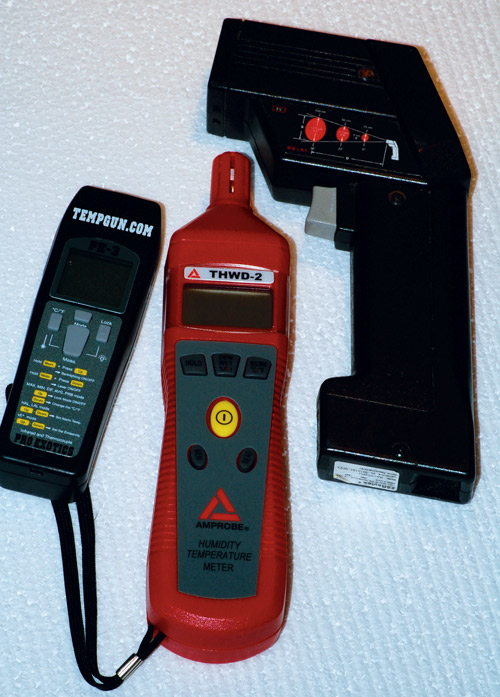
A variety of quick-read temperature and humidity gauges are available to today’s keeper
Observation is a key element in providing a temperature range. If the herp doesn’t use a particular area of a cage, adjusting the ambient and/or basking temperature by a degree or two may help. Other factors may also come into play. For example, if you’re maintaining multiple animals within a cage, less dominant individuals may not have the same access to certain areas of the enclosure that more dominant individuals do. Likewise, extremely shy species might not use certain areas because they may feel exposed to possible dangers. Therefore, experimentation may be necessary to get an acceptable result.
The primary goal of this article is to provide an overview of the heating and cooling options available to create a successful thermal environment for your amphibian or reptile.
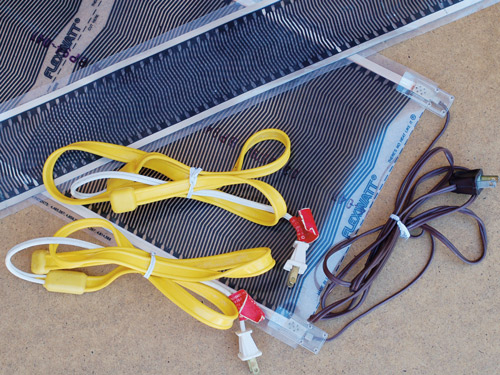
Heat tape comes in a variety of sizes and is useful when heating a number of cages at a time.
Setting Up a Reptile Room
For those of you living in cooler climates, heating your herps can be a challenge. The same can be said about keeping herps cool in places with triple-digit summer temperatures. Fortunately, a variety of heating and cooling options are available to the hobbyist.
Before manipulating cage temperature, first consider the room’s ambient temperature. Cage location can mean everything. Choosing an appropriate room in your house can mean the difference of several degrees in the ambient temperature. Rooms that face the west or south are likely to be slightly warmer than those facing east or north. In two-story residences, keeping herps downstairs or even in the basement will mean lower ambient temperatures. The opposite is true when trying to heat your herps. Heat rises, therefore, rooms located above the ground floor are warmer than those below. Even within a room, a considerable temperature gradient may exist vertically. Position cages on a shelving unit according to the species housed within. Keep animals that favor slightly cooler temperatures on the lower shelves (closer to the floor), and keep those species that may be more sensitive to cooler temperatures on the upper shelves. If your windows face the sun, a window shade will also help keep the inside temperatures cooler.
Depending upon the size of your collection and/or the size of your herps, manipulating the temperature in an entire room can be a very good idea, provided all the species are similar in their requirements. Central air and individual air conditioning units are the most widely used cooling options. However, in the case of central air, having a permanently affixed thermostat located in another room can be an obstacle. For those living in drier climates, the use of an evaporative or “swamp cooler” is another option for maintaining cooler temperatures. Forcing the warmer outside air through water-soaked pads, swamp coolers can effectively cool the air by 10 to 20 degrees Fahrenheit. Other cooling options include misting and fogging devices, which both work by an evaporative cooling process.
While many room air conditioners have a heating option, the use of a space heater offers a simple solution for creating warmth. Space heaters can quickly heat up a room, so purchasing one with a built-in thermostat is a must. Placement of the space heater can be critical. Try to position the heater in a central part of the room, away from close proximity to any animals, water and fire hazards. Areas that are subject to cold drafts should also be avoided, due to the chance of the heater staying on while the rest of the room overheats.
Maintaining a room several degrees under the desired target temperature will allow you to still use small heating devices on individual cages in order to provide adequate basking or warm areas if desired. Consider the overall design of each enclosure before adding a heating apparatus. Because heat rises, close-topped cages with air vents located on the side are more likely to retain heat, much more so than screen-topped enclosures. Therefore, before placing a herp within an enclosure, exercise caution and adjust the heating apparatus accordingly.
Terrestrial and Arboreal Reptile Climate Control
A variety of equipment is available for heating specific caging units. Here are a few options:
Heat Tapes: Heat tapes and cables are subfloor heating options. Consisting of heating elements encased in a plastic or other synthetic material and wired to an electrical plug, many of the first heat tapes used with herps were actually manufactured for heating pipes during the winter months. Others have since been manufactured expressly for the amphibian and reptile industry. All heat tapes and cables should only be used with a regulatory device, such as a rheostat (popularly known as a dimmer switch) or a thermostat, not only to fine-tune the output, but also to act as a safety mechanism in case of a malfunction (which does occasionally occur) in the heat tape.
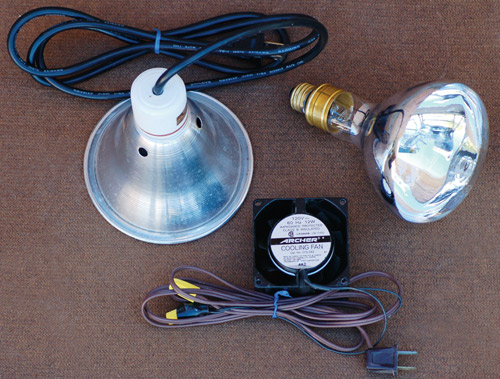
Ceramic light fixtures (left) are necessary when using high-intensity heat sources, such as mercury vapor ultraviolet bulbs (right). Small computer fans (bottom) are excellent for mounting directly outside air vents to help prevent heat build up in cages with poor ventilation.
I use a type of heat tape known as Flex Watt Heat Tape. Slightly different from conventional heat tapes, this particular brand consists of a thin plastic sheet with a heating element sandwiched in the middle. The extremely thin design conveniently lends itself to neatly fit under most flat-bottomed cages. Flex Watt Heat Tape is available in several different widths, can be cut to any length, and is generally sold by the foot, which lets the keeper custom fit it to almost any enclosure. A set of clips, plastic clip protectors and a prewired plug are needed to complete the setup, so this type of heat tape requires some electrical knowledge. However, many retailers can make these connections for the purchaser. As mentioned previously, use of a rheostat or a thermostat with this (or any type) of heat tape is strongly recommended, as they can get very hot and problems can occur if this product exceeds 95 degrees.
Heat Pads: Like heat tapes, heat pads come in a variety of configurations and sizes. They offer certain advantages over many heat tapes in some applications, because they can heat a wider area, and in some cases are able to be placed directly into the enclosure. In this case, make sure that the heat pad is waterproof. One particular variety is called a “pig blanket.” Not exactly a blanket, the term “pig blanket” is used with larger plastic or fiberglass heat pads that are manufactured for the farm industry. Pig blankets are extremely useful with larger herps, such as monitors, tortoises and pythons, and they can be placed directly in an enclosure, provided that certain precautions are followed. Like heat tapes, the use of a regulatory device, such as a rheostat or thermostat, is strongly recommended with the use of any heat pad. It also helps to keep the surface temperature at a reasonable level to avoid thermal burns and other problems.
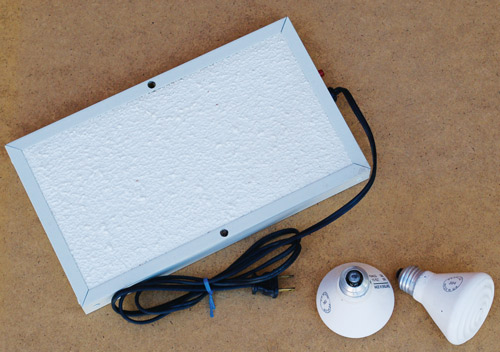
Two examples of non-light-emitting heaters include radiant heat panels and infrared ceramic bulbs
Hot Rocks: Hot rocks, as the name implies, are rock-shaped heating devices meant to be used directly in an enclosure. In the past, hot rocks had the reputation of causing thermal burns on herps. However, in recent years, improvements have helped change their reliability and reputation. Primarily made for small reptiles, hot rocks allow the cage’s inhabitant the opportunity to “bask,” or thermoregulate as needed, without using an incandescent bulb positioned overhead. Depending upon the manufacturer, the hot rock can be used on the surface or may need to be buried in the substrate. Either way, monitor the surface temperature for these artificial rocks frequently. The heat should stay well below triple digits. Like many heating devices, the use of a rheostat will help regulate the temperature. Hot rocks are not meant to heat entire enclosures and should not be used in this way.
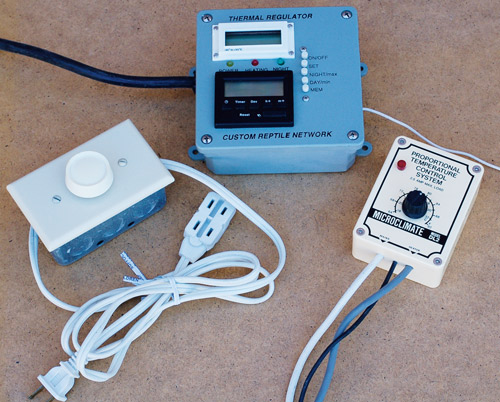
Three devices that offer the hobbyist some flexibility to control heating include (from left to right): a rheostat (also called a dimmer switch), a traditional thermostat and a pulse proportional thermostat.
Lighting: There are a variety of lighting options that can effectively increase the temperature, including incandescent, infrared and mercury vapor lamps. Incandescent spot or floodlights, easily the most commonly used of the three, have advantages in that they come in a variety of wattages, are inexpensive and are widely available. For larger enclosures, infrared lighting is a good option, because these bulbs can be used at night without altering the animal’s light cycle. Another option for larger enclosures, especially if the species requires ultraviolet light, is a mercury vapor lamp. Like infrared lighting, these will get incredibly hot and must be used with caution. They are also somewhat more expensive than regular bulbs, but the fact that they generate UVB makes them very desirable. Whichever bulb you decide to use, exercise safety with its placement and avoid letting the bulb come into direct contact with the animal or anything flammable.
Ceramic Heating: Ceramic heating elements answer the need when you desire a concentrated heat source but do not want light. Producing an infrared wavelength, these heaters do not actually heat air; they heat objects below the heating element. Similar to a light bulb in shape, ceramic heaters come in several wattages and can be screwed directly into a standard household lighting fixture, but use of a ceramic socket is strongly recommended due to the heat that these units generate. They will burn anything that they come in to contact with, so never place a ceramic heater in a cage where the occupant may potentially reach the ceramic heater.
Radiant Heat Panels: Radiant heat panels offer another way to heat the occupant of an enclosure without adding light. This is a bonus when used with nocturnal species. These provide heat by way of heat transfer, warming animals directly instead of warming the air. Radiant heat panels are a good choice for arboreal species, because the panel can be placed immediately adjacent to a perching area. Unlike ceramic heaters and light bulbs, the surface area of a heat panel does not get hot and can be touched.
Fans: Fans are not only a great way to distribute air within a room, but they can also be used effectively with individual caging to help alleviate the buildup of heat. Small AC or DC fans, generally sold for computers in electronic stores, can be mounted directly outside an air vent for exhaust purposes.
Heating and Cooling Aquatic Reptile Environments
There are a variety of aquarium heaters to choose from, including side-mounted, fully submersible and cable heaters. Side-mounted or semi-submersible heaters are generally the least expensive of the three and probably the least usable because of their inherent design of requiring mounting partially in as well as out of water. The problem is the mounting bracket on most side-mounted heaters is generally meant to be secured on the lip of the aquarium, where the top of the heater will remain dry while the lower glass-encased heating element is submerged underwater. Subsequently, the placement of the heater may severely compromise the use of an adequate security lid meant to keep your herp inside its enclosure. This type of heater also requires a water level close to the aquarium’s top, making shallow-water applications impossible.
Fully submersible heaters offer the greatest flexibility in that they can be placed anywhere underwater, including some units designed to fit in external filters. Because of the surface heat associated with these heaters, a piece of PVC pipe can be used as a sleeve to cover the heater to prevent direct contact with the enclosure’s inhabitant. Submersible-cable heaters, intended to be buried in the substrate, offer still another choice for heating an aquatic environment. Whichever design one chooses, all are usually available with built-in thermostats to accurately control the water temperature.
Unless you have a basement that can maintain cool temperatures year round, a chiller unit is necessary to keep aquatic salamanders, such as hellbenders (Cryptobranchus alleganiensis). The unfortunate side of chiller units is the price tag; most are in the $500 to $2,000 range. However, if maintaining specialized aquatic amphibians, you must be able to provide the temperatures necessary for success. In the process of cooling water, chiller units generate a fair amount of external heat, and therefore an air conditioned room is also a consideration when using this equipment.
Reptile Heating Tips
A general rule of thumb to follow when selecting an aquarium heater is to allow 3 to 5 watts per gallon of water in order to maintain your herp at optimal temperatures.
Reptile Enclosure Temperature Regulation
With the exception of air conditioning units, space heaters, and aquarium heaters and chillers (many of which have built-in thermostats), many heating and cooling devices must be regulated to achieve a desired temperature. Rheostats, traditional thermostats and pulse-proportional thermostats offer the hobbyist a degree of flexibility from which to choose.
Rheostats are used to manually adjust the electrical current, and thus the output (such as heat) of the unit to which they are attached. Dimmer switches are easy to construct from parts found in a hardware store and can be purchased completely assembled.
Thermostats supply current to a heating device by a simple on-and-off function. Once the preset temperature is reached, the current is automatically switched off until the temperature falls below the preset temperature. On the other hand, a pulse-proportional thermostat pulses the current to the heating device until a set temperature is reached. Unlike a regular thermostat, however, these units never switch off but maintain a steady, though diminished, current to the heater. Both traditional and pulse-proportional thermostats offer a nighttime drop function, a handy feature when lower temperatures are required at night.
Reptile Thermometers
An essential piece of equipment for maintaining herps, both traditional and digital thermometers are widely available at relatively inexpensive prices. Digital models are not only easy to read, but they also usually offer certain advantages over traditional thermometers, including a high- and low-memory and a humidity function. Hand-held digital thermometers or temperature “guns” that offer the ability to quickly read a temperature are excellent to use for maintenance purposes.
In closing, because so many important biological processes are temperature-dependent in herps, it is essential to provide a proper thermal environment in order to successfully maintain amphibians and reptiles in captivity. By selecting the right type of heating or cooling equipment for a particular species, you can create and fine-tune a habitat that will optimize the health and welfare of your animals. Ultimately, the efforts you put into your hobby will be reflected by the personal successes you achieve with your herps.



